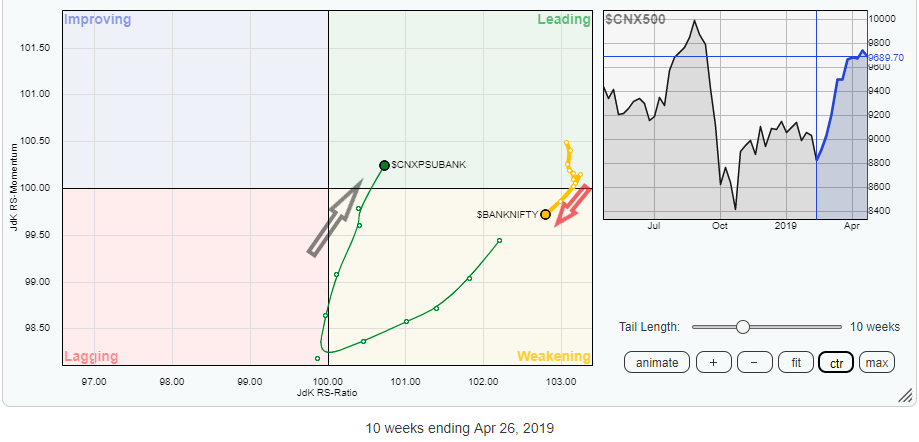We head in to a month that is set to be among the most volatile and eventful as the market faces one of the most important domestic events – General Election Results.
The equity markets are currently hovering around their lifetime highs. On the one hand, they grapple with a not-so-favorable technical setup, showing persistent bearish divergence against its lead indicators. On the other hand, in the event of any favorable election outcome, we might see sporadic sharp up-moves happening. Amid this environment, an interesting rotation can be observed if we compare PSU Bank Index and BankNIFTY, which has primarily private banks as its main constituents.
In the above Relative Rotation Graph (RRG), we compare PSUBank Index and BankNIFTY against the benchmark broader market index CNX500. As per the 10-week trail of both indexes, we observe that BankNIFTY has moved into the weakening quadrant from the leading quadrant. This has happened while the BankNIFTY has consistently lost relative momentum over past 10 weeks.
On the other hand, it can be seen that the PSU Bank Index has shown a sharp surge in relative momentum and has crawled back in to the leading quadrant. In addition, it is worth taking note of the PSU Bank Index, which has bypassed the usual completion of the clockwise cycle. Under normal circumstances, the index would have moved from weakening to lagging quadrant and, from there, into the improving quadrant and finally the leading quadrant. Instead, it has moved directly from the lagging quadrant to leading quadrant, owing to sharp improvement in its relative strength and momentum against the broader CNX500 index.
The construction of BankNIFTY index is highly skewed in favor of private sector banks. The top four banks - HDFC Bank, ICICI Bank, Kotak Mahindra Bank and Axis Bank - represent 73.77% of the index. The PSU Bank index, on the other hand, has State Bank of India, Bank of Baroda and PNB representing over 62.88% of the index.
From the above reading, we cannot directly jump to the conclusion that private banks are set for a decline or PSU banks are set for an up-move. However, we can surely draw one conclusion, that being that PSU banks are set to strongly out-perform the private banks on a relative basis over the coming week.
In the event of a general decline in the markets, we will see BANKNIFTY taking a much larger hit as compared to PSU banks. In the event of an up-move in the markets, the potential upsides in the PSU banks will be much higher as compared to the BANKNIFTY.
Important Note: RRG™ charts show you the relative strength and momentum for a group of stocks. In the above chart, they show relative performance as against the NIFTY500 Index (Broader Markets) and should not be used directly as buy or sell signals.
Milan Vaishnav, CMT, MSTA
Consulting Technical Analyst
www.EquityResearch.asia
